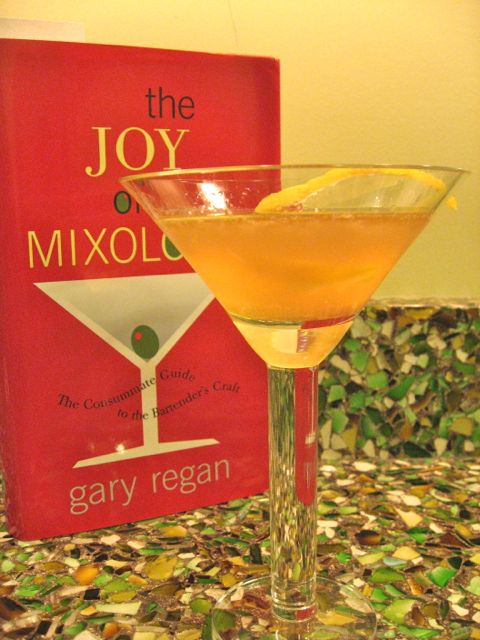Okay, here’s a confession. I always ask bartenders which cocktail books are essential. They always recommend The Joy of Mixology. I always nod knowingly, pretending I’ve read it. But I hadn’t. Until now.
I finally ordered a copy from Rainy Day Books and have spent the last few nights combing its pages, dog-earing and underlining as I go. The book is everything I expected, and then some.

Gary Regan published The Joy of Mixology in 2003, after years of serving up and writing about booze, and he continues to be a force in the industry. Eddie Crane considers the book required reading for anyone wanting to tend bar at The Drop, probably because of Regan’s thorough, commonsense advice on what it takes to be a good bartender.
There’s also history (who knew bartenders in the Wild West were sometimes called ganymedes?). Basic bartending philosophy, such as how to deal with a bad tipper (treat them like anybody else). Why individual taste trumps all other mixology theory. And where some books use step-by-step photography to demonstrate various techniques, Regan teaches readers how to stir drinks and cut garnishes with nothing more than precise descriptions and a few line drawings.
But what makes this book as useful to the amateur as it is to the pro is Regan’s approach to making drinks. All 350 recipes are sorted into family groups, which Regan admits isn’t an entirely new idea. But until The Joy of Mixology came out, no one else had edited these families so smartly, adding charts to illustrate their relationships and creating a template that’s much easier to memorize than hundreds of individual cocktail recipes.
“Once you know the formula for, say, New Orleans Sours, the family in which you’ll find the Margarita and the Sidecar, you will understand that the Kamikaze is just a vodka-based Margarita, and that the Cosmopolitan, using citrus vodka as a base, follows the same formula, with just a little cranberry juice thrown in for color,” Regan writes.
Let’s take those sours. Regan defines them as drinks with a base spirit, lime or lemon juice and a non-alcoholic sweetener like simple syrup, grenadine or pineapple juice. He includes 20 sour recipes, as well as another few dozen in four subcategories.
International sours are sweetened by a liqueur, fruit juice or both; New Orleans sours contain triple sec or another orange-flavored liqueur. Sparkling sours are topped with something fizzy, while squirrel sours are the result of “Mardee (Regan) insisting that we buy some créme de noyau, a pink almond-flavored liqueur.” (For more on what this is, and how you can even make your own, check out this Stirred, Not Shaken post.)
It was in this section that I happened across the Leap-Year Cocktail. And since today’s Feb. 29, I of course had to make one, just like everyone else publishing a leap year cocktail recipe today.
This International sour is made with gin, Grand Marnier, sweet vermouth and lemon juice. But which gin? Regan adapted the recipe from one published in Harry Craddock’s The Savoy Cocktail Book, but The Joy of Mixology came out before the resurgence of historical gin styles. So, I started with London Dry, which is mostly what was on the market back in 2003.
The results were jangly, with gin botanicals clashing against the liqueur and vermouth. Slate had much the same reaction, probably thanks to its use of Plymouth gin. For the second round, I switched to Hayman’s Old Tom gin, a style popular in the eighteenth and nineteenth centuries that returned to the market a couple years ago. Did it make a difference? Absolutely. Hayman’s has citrus and spice notes, a touch of cane sugar sweetness and more viscosity—all of which blended with the other ingredients to create a balanced, refreshing drink.
I’ll confess, it was tasty enough that there’s no way I’m waiting four more years to make another.
Leap-Year Cocktail: Combine 2 ounces gin (preferably Hayman’s Old Tom gin), 1/2 ounce Grand Marnier, 1/2 ounce sweet vermouth (I used Dolin Rouge) and 1/4 ounce fresh lemon juice in a cocktail glass. Fill partway with ice and shake. Strain into a chilled cocktail glass. Garnish with a lemon twist.
For more leap year fun, try making your own grenadine, celebrating at the Center for Urban Education about Sustainable Agriculture in San Francisco (sorry to include an impossibility, just wishful thinking on my part) or click “leave a comment” to tell me what you’re drinking!